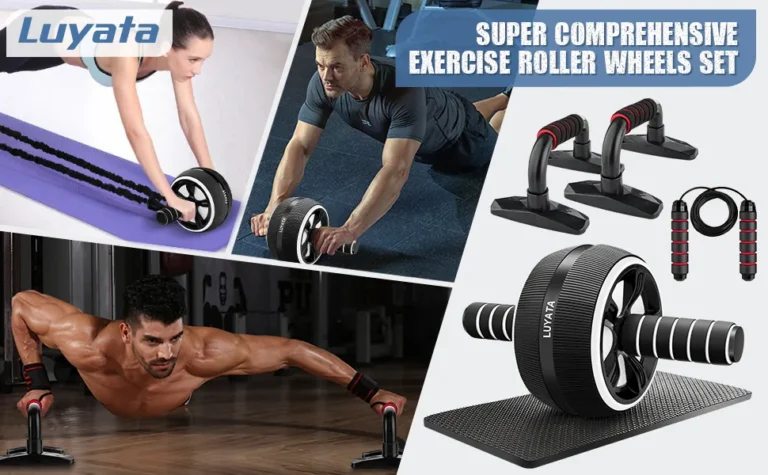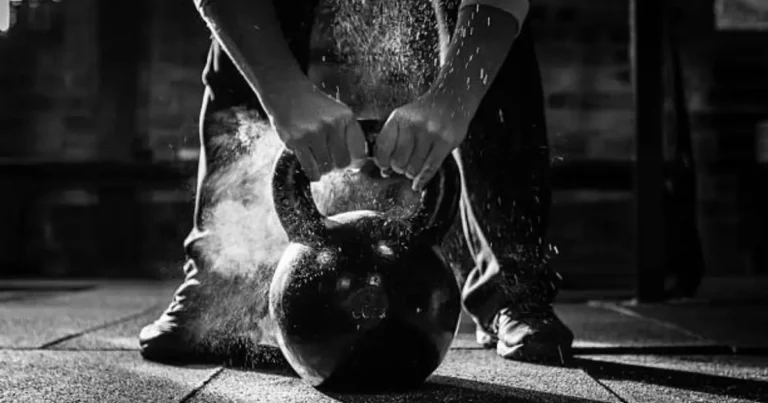The Ultimate Kettlebell Back Workout: Build Strength, Improve Posture & Forge Power
Introduction
Imagine a kettlebell back workout that not only sculpts a V-shaped torso but also banishes back pain and boosts your daily functional strength. Many lifters struggle to build a resilient posterior chain, leading to poor posture and nagging discomfort. Enter targeted kettlebell training: the perfect tool for spinal stability, scapular control, and hip hinge mastery. In this guide, you’ll learn back anatomy, why kettlebells reign supreme, must-do exercises (including kettlebell good mornings), program templates, safety tips, and expert insights to transform your back strength and posture.
Table of Contents
Why Kettlebells are King for Back Training

- Enhanced Grip & Pulling Power
Kettlebell handles demand constant grip engagement, reinforcing forearm strength and improving deadlift and rowing performance. - Core & Stabilizer Activation
The offset load forces the erector spinae and deep core to brace continuously, boosting spinal stability. - Hip Hinge Proficiency
Swings and kettlebell deadlifts cement the hip hinge pattern, a foundational movement for lower back health. - Full Posterior Chain Integration
Moves like swings, deadlifts, and good mornings simultaneously target glutes, hamstrings, and lower back, maximizing efficiency. - Functional Carryover
Farmer’s and suitcase carries translate directly to real-world tasks—improving posture and carrying mechanics.
“Strong backs aren’t built with machines—they’re forged with free weights that challenge every stabilizer.”
Understanding Your Back Muscles (Brief Anatomy Lesson)
| Muscle | Function |
|---|---|
| Latissimus Dorsi (Lats) | Shoulder extension & width |
| Trapezius (Traps) | Scapular elevation, mid-back thickness |
| Rhomboids | Scapular retraction & posture |
| Erector Spinae | Spinal extension & lower back support |
Understanding these groups helps you select exercises that hit every layer of your back kettlebell workout.
Safety First: The Non-Negotiables for Kettlebell Back Training
- Master the Hip Hinge
- Hinge at the hips, not the knees; imagine closing a car door with your glutes.
- Maintain a Neutral Spine
- Keep ears over shoulders and hips over heels—no rounding.
- Brace Your Core
- Inhale into the belly, then tighten like prepping for a punch.
- Control Your Scapulae
- Initiate rows by retracting shoulder blades, not bending elbows.
- Choose Appropriate Weight
- If form breaks, drop down a bell size. Prioritize control over ego.
- Coordinate Breathing
- Exhale on exertion (the lift/pull), inhale on return.
Tip: Film yourself from the side to check hinge depth and spinal alignment before adding load.
The Best Kettlebell Exercises for a Powerful & Healthy Back
Rows
Single-Arm Kettlebell Row

- Targets: Lats, rhomboids, traps
- How-To:
- Place one hand and knee on bench; other foot grounded.
- Grip KB, hinge forward, spine neutral.
- Pull elbow up, squeezing shoulder blade.
- Lower with control.
- Pro Tip: Lead with the elbow—not the wrist—to engage lats.
Renegade Row (Advanced)
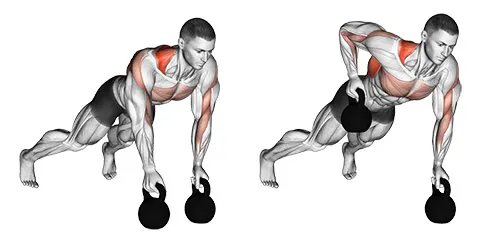
- Targets: Lats, core stabilizers
- Variation: In plank, row KB while keeping hips square—builds anti-rotation strength.
Hinges / Deadlifts
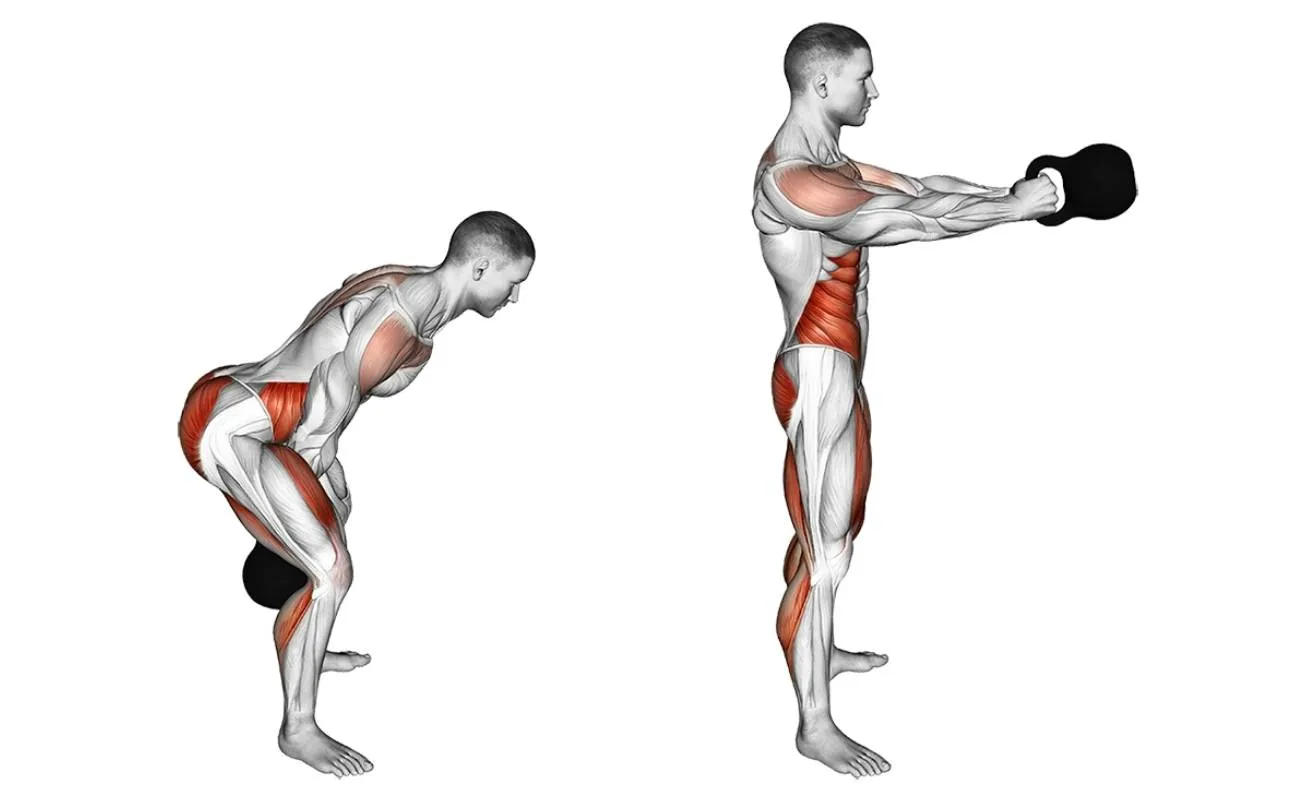
Kettlebell Deadlift (Sumo & Conventional)
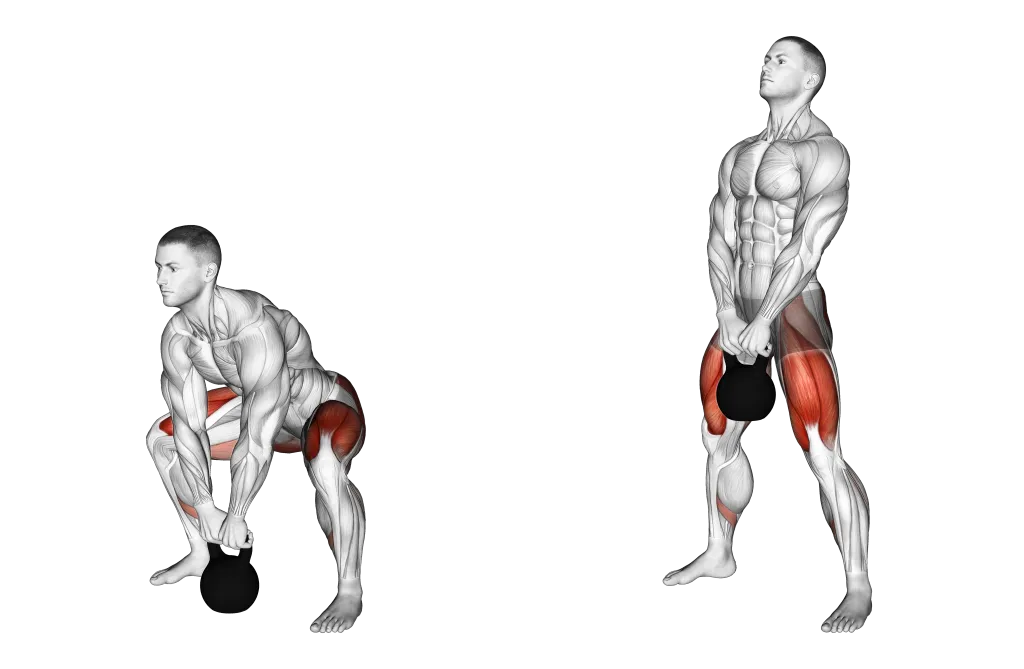
- Targets: Erector spinae, glutes, hamstrings
- How-To:
- Feet hip-width (conventional) or wide (sumo), KB between feet.
- Hinge hips back, grip bell.
- Drive hips forward, standing tall.
- Hinge back down.
- Common Mistake: Rounding lower back—keep a proud chest.
Kettlebell Good Morning

- Targets: Erector spinae, hamstrings
- How-To:
- Place KB on upper traps (like a barbell).
- Soft knees, hinge deeply at hips, keeping spine neutral.
- Return by driving hips forward.
- Variation: Single-leg for added stability challenge.
Swings
Two-Hand Kettlebell Swing
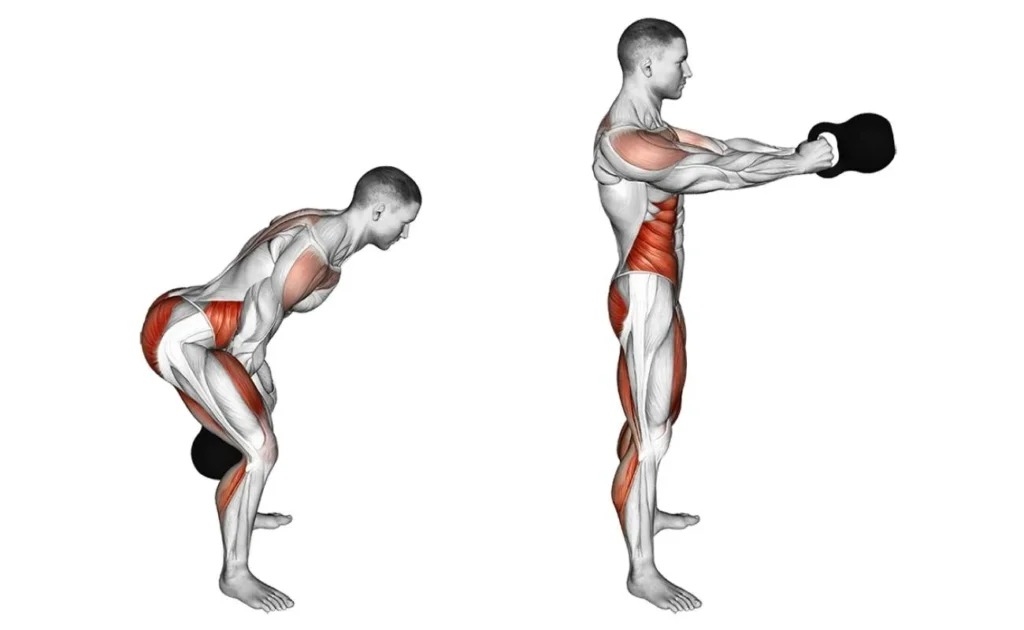
- Targets: Glutes, hamstrings, lower back
- Why It Works: Teaches explosive hip drive and trains spinal bracing under load.
Single-Arm Swing
- Targets: Same as two-hand, plus anti-lateral flexion challenge for erectors.
Carries
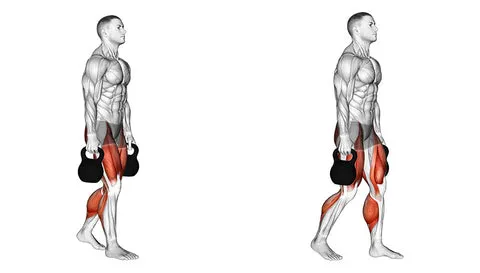
Farmer’s Carry
- Targets: Traps, lats, core
- How-To: Walk holding two bells at sides, shoulders down, core tight.
Suitcase Carry
- Targets: Obliques, spinal stabilizers
- How-To: Carry single bell at one side; resist leaning toward load.
Other
- Kettlebell Pullover: Stretches and engages lats.
- Kettlebell Snatch: Advanced move that challenges the entire posterior chain dynamically.
Designing Your Kettlebell Back Workout
- Weight Selection:
- Rows: 50–70% of your swing weight
- Hinges/Good Mornings: 70–90% of swing weight
- Sets × Reps Guidelines: GoalSets × RepsRestStrength4–5 × 4–690–120 sHypertrophy3–4 × 8–1260–90 sEndurance/Posture3 × 15–2045–60 s
- Frequency: 1–2 dedicated back days/week; integrate indirect work (swings/carries) on other days.
- Warm-Up:
- Cat-Cow, band pull-aparts (2×15), hip hinge drills (2×8), light halos (2×10).
- Cool-Down:
- Child’s pose, lat stretch on wall, thoracic extension over foam roller (hold 30 s each).
Sample Kettlebell Back Workout Programs
Beginner Back Foundations Program
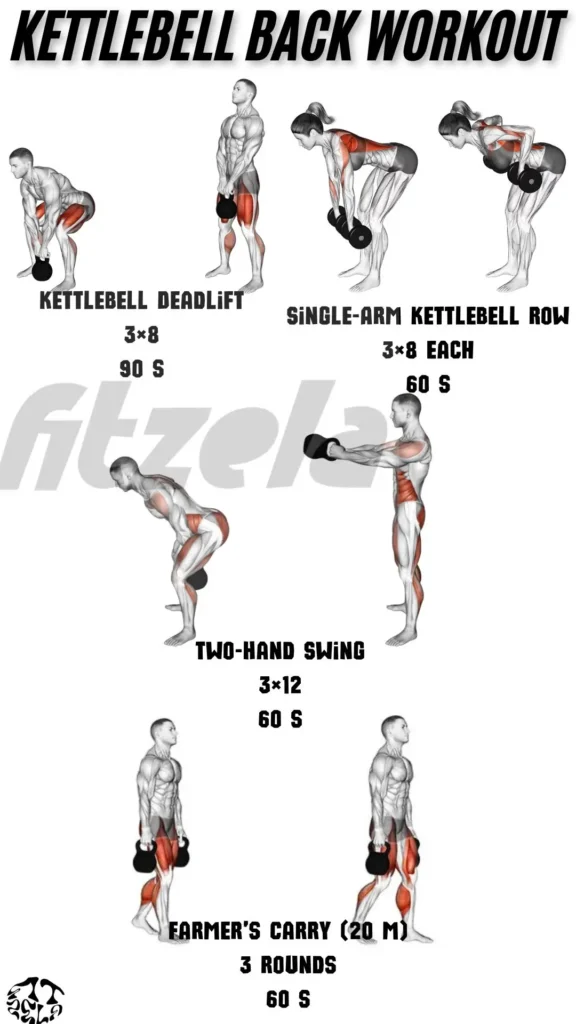
| Exercise | Sets × Reps | Rest | Notes |
|---|---|---|---|
| Kettlebell Deadlift | 3×8 | 90 s | Focus on hinge mechanics |
| Single-Arm Kettlebell Row | 3×8 each | 60 s | Keep spine neutral |
| Two-Hand Swing | 3×12 | 60 s | Drive hips, not arms |
| Farmer’s Carry (20 m) | 3 rounds | 60 s | Brace core |
Intermediate Back Strength Builder Program
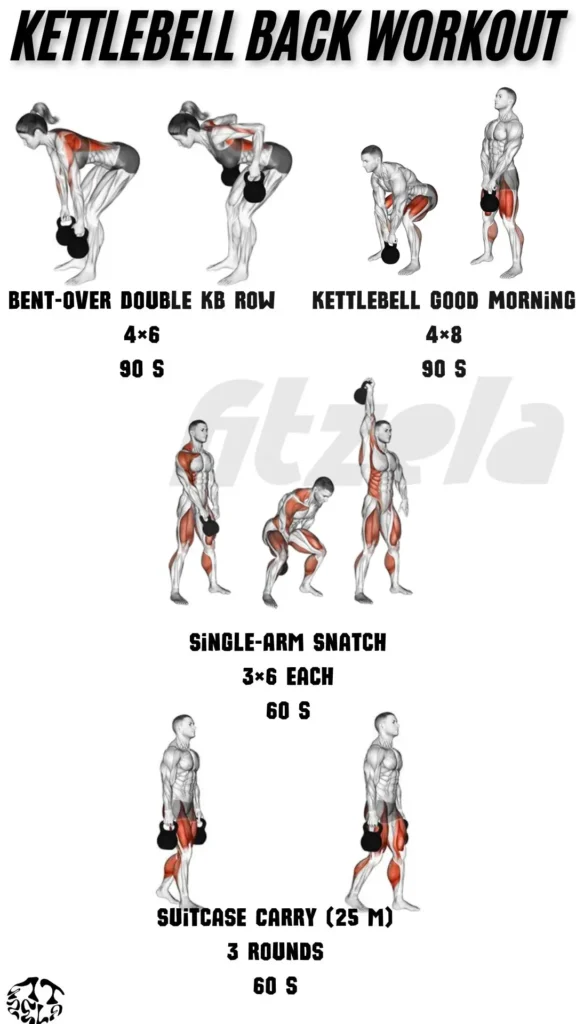
| Exercise | Sets × Reps | Rest | Notes |
|---|---|---|---|
| Bent-Over Double KB Row | 4×6 | 90 s | Use moderate weight |
| Kettlebell Good Morning | 4×8 | 90 s | Hinge deep, spine neutral |
| Single-Arm Snatch | 3×6 each | 60 s | Emphasize controlled lockout |
| Suitcase Carry (25 m) | 3 rounds | 60 s | Switch sides each round |
Upper Back Hypertrophy Program
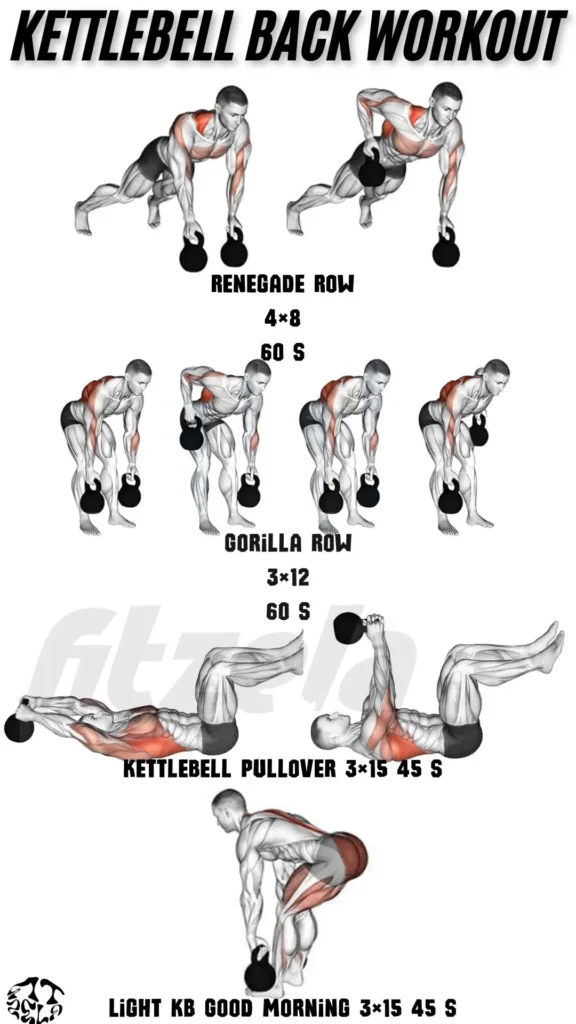
| Exercise | Sets × Reps | Rest | Notes |
|---|---|---|---|
| Renegade Row | 4×8 | 60 s | Keep hips square |
| Gorilla Row | 3×12 | 60 s | Wide stance for ROM |
| Kettlebell Pullover | 3×15 | 45 s | Control the descent |
| Light KB Good Morning | 3×15 | 45 s | Focus on tempo |
Lower Back Health & Posture Program
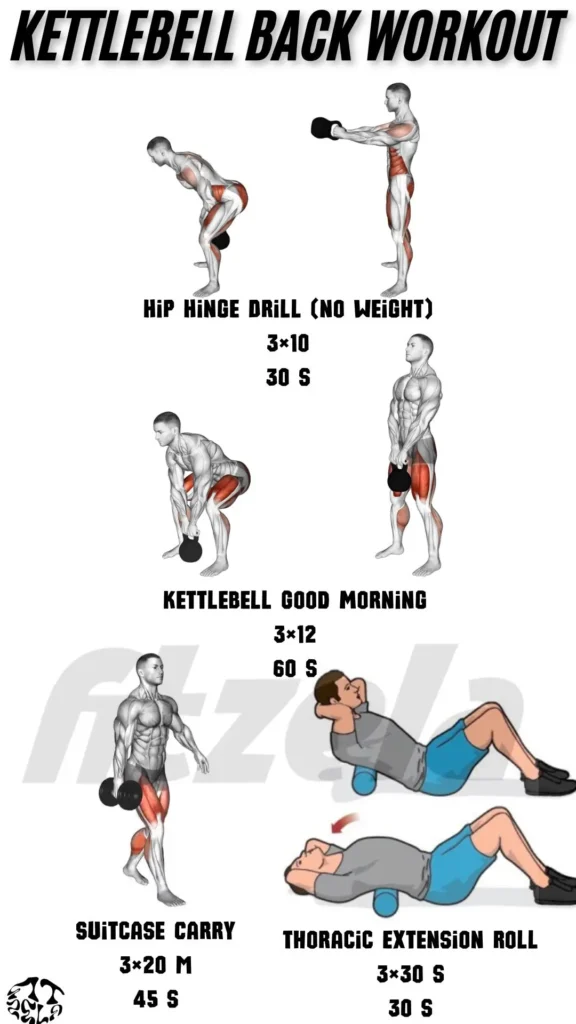
| Exercise | Sets × Reps | Rest | Notes |
|---|---|---|---|
| Hip Hinge Drill (no weight) | 3×10 | 30 s | Perfect form only |
| Kettlebell Good Morning | 3×12 | 60 s | Moderate load, slow tempo |
| Suitcase Carry | 3×20 m | 45 s | Resist lateral lean |
| Thoracic Extension Roll | 3×30 s | 30 s | Open upper back |
Avoiding Common Kettlebell Back Training Pitfalls
- Rounding the Lower Back: Sacrifices spinal integrity—pause and reset if you slump.
- Pulling with Arms: Initiate each row with scapular retraction, not elbow flexion.
- Hyperextension at Lockout: Especially on swings—finish upright, not overarched.
- Excessive Momentum: Control the descent; avoid “bouncing” reps.
- Neglecting Core Bracing: Always brace before you pull or hinge.
Progressing Your Kettlebell Back Training
- Increase Weight: When you can hit top reps with perfect form and RPE ≤7.
- Add Reps/Sets: +1–2 reps per set or +1 set every 2 weeks.
- Decrease Rest: Trim rest by 5–10 seconds to raise intensity.
- Refine Technique: Record sessions to catch subtle form breakdowns.
- Advance Variations: Move from single-arm rows to renegade rows, or from two-hand swings to single-arm swings.
Conclusion
A focused back kettlebell workout unlocks stronger lats, thicker traps, and a resilient lower back—all while improving posture and functional strength. Prioritize form, safety, and progressive overload: hinge, brace, retract, and repeat. Ready to strengthen your posterior chain? Pick a program, load your kettlebell, and master your technique—your back will thank you!



